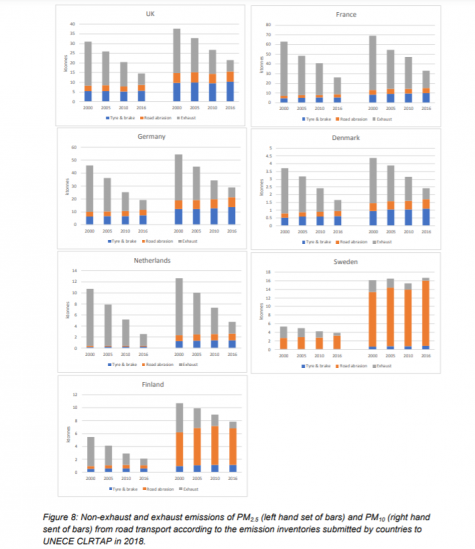
Over the past 20 years, international and national vehicle regulations have introduced increasingly stringent ceilings on particulate emissions (PM 2.5 and 10) from vehicles’ exhaust.
As a result, according to the emission inventories submitted by countries to UNECE’s Convention on Long-range Transboundary Air Pollution (CLRTAP), in many European countries, including Denmark, Finland, France, Germany, the Netherlands, Sweden and the UK, volumes of exhaust emissions of particulate matter have been significantly reduced, in most cases divided by a factor of between 3 and 4 between 2000 and 2016.
But non-exhaust sources from road traffic such as road, tyre and brake wear, which are also identified sources of particulate emissions harmful to human health and the environment, have not been equally targeted. Their share in total particulate matter (PM) emissions from road transport has thus risen significantly. With the foreseen growth in market share of electric and hybrid vehicles, this trend will only increase in coming years. Therefore, non-exhaust sources must now be targeted in order to achieve further gains in the fight against particulate matter.
New steps are being taken to achieve this thanks to the World Forum for Harmonization of Vehicle Regulations’ Working Party on Pollution and Energy (GRPE), which has initiated activities to develop a rigorous test procedure to measure brake particle emissions under standardized conditions.
A braking test cycle based on the Worldwide harmonized Light vehicles Test Procedure (WLTP) database that is used to measure exhaust emissions from cars has already been developed.
Further work will be needed to determine how to handle conventional and non-conventional Light-Duty vehicles (i.e. hybrids, electric cars), as well as trucks. In addition, GRPE will also need to assess how to take into account technologies such as regenerative braking systems used to recharge batteries in electric and hybrid vehicles, and more generally Advanced driver-assistance systems (ADAS), which are changing the way braking systems are used.
A final testing procedure is expected to be discussed by GRPE at its June 2022 session, with a view to its subsequent adoption by the World Forum for Harmonization of Vehicle Regulations.
Figure 1

Source:
Note to editors
About the World Forum for Harmonization of Vehicle Regulations
The World Forum for Harmonization of Vehicle Regulations, hosted by UNECE, is a unique global platform responsible for the regulatory frameworks regarding the safety and environmental performance of vehicles, their subsystems and parts.
The World Forum manages three Global Agreements on vehicles: 1958 Agreement (UN Regulations); 1998 Agreement (UN Global Technical Regulations); and 1997 Agreement (UN Rules on Periodic Technical Inspections). Any country that is member of the United Nations may participate in the activities of the World Forum and accede to the Agreements.
United Nations Global Technical Regulations (UN GTRs) contain globally harmonized performance-related requirements and test procedures. They provide a predictable regulatory framework for the global automotive industry and consumer associations. They do not contain administrative provisions for type approvals and their mutual recognition.
The Working Party on Pollution and Energy (GRPE) is one of the six subsidiary bodies of the World Forum. It concentrates its work on defining exhaust, energy efficiency and power measurement procedures for all modes of inland transport in order to limit environmental damage. GRPE will be in charge of the development of the UN GTR on real driving emissions testing.
About brake emissions measurement
When activating the brake pedal, friction between the brake disc and brake pads slows down the vehicle and generates heat; in this process, small parts of the disc and pads are emitted in the form of airborne particulate matter that can be breathed in by humans and also negatively impact the environment.

